Family: Xyelidae
Family common name: xyelid sawflies
Subfamily: Macroxyelinae
Tribe: Macroxyelini
Genus: Megaxyela Ashmead, 1898
Subgenera: none
The Xyelidae hold status as the most primitive family, not only of the sawflies, but of all Hymenoptera. The xyelids are usually associated with a primitive plant group, coniferousconiferous:
describing a conifer
trees (Ross 1932, Blank and Kramp 2017Blank and Kramp 2017:
Blank SM and Kramp K. 2017. Xyela davidsmithi (Hymenoptera, Xyelidae), a new pine catkin sawfly with an unusual host association from the Sierra Nevada. Proceedings of the Entomological Society of Washington 119 (Special Issue): 703-717.). The Macroxyelinae subfamily, however, is associated with angiosperms, and is likely the most primitive group of extantextant:
in existence; opposite of extinct
sawflies in the world (Smith and Schiff 1998Smith and Schiff 1998:
Smith DR and Schiff NM. 1998. The genera Macroxyela Kirby and Megaxyela Ashmead (Hymenoptera: Xyelidae) in North America. Proceedings of the Entomological Society of Washington 100 (4): 636-657.).
Megaxyela adults are large, 8–15 mm in length, with distinctively long legs and orange/red coloration. Despite these easily noticeable characters, they are rarely observed (Smith and Schiff 1998Smith and Schiff 1998:
Smith DR and Schiff NM. 1998. The genera Macroxyela Kirby and Megaxyela Ashmead (Hymenoptera: Xyelidae) in North America. Proceedings of the Entomological Society of Washington 100 (4): 636-657., Blank et al. 2017Blank et al. 2017:
Blank SM, Kramp K, Smith DR, Sundukov YN, Wei M, and Shinohara A. 2017. Big and beautiful: the Megaxyela species (Hymenoptera, Xyelidae) of East Asia and North America. European Journal of Taxonomy 348: 1-46.)
There are 13 described extantextant:
in existence; opposite of extinct
species worldwide. Seven occur in North America (Taeger et al. 2010Taeger et al. 2010:
Taeger A, Blank SM, and Liston AD. 2010. World Catalog of Symphyta (Hymenoptera). Zootaxa 2580: 1-1064., Blank et al. 2017Blank et al. 2017:
Blank SM, Kramp K, Smith DR, Sundukov YN, Wei M, and Shinohara A. 2017. Big and beautiful: the Megaxyela species (Hymenoptera, Xyelidae) of East Asia and North America. European Journal of Taxonomy 348: 1-46.).
A key to NearcticNearctic:
describing the region of the Northern Hemisphere that includes North America south through northern Mexico
 species of Megaxyela is included in Smith and Schiff 1998Smith and Schiff 1998:
species of Megaxyela is included in Smith and Schiff 1998Smith and Schiff 1998:
Smith DR and Schiff NM. 1998. The genera Macroxyela Kirby and Megaxyela Ashmead (Hymenoptera: Xyelidae) in North America. Proceedings of the Entomological Society of Washington 100 (4): 636-657..
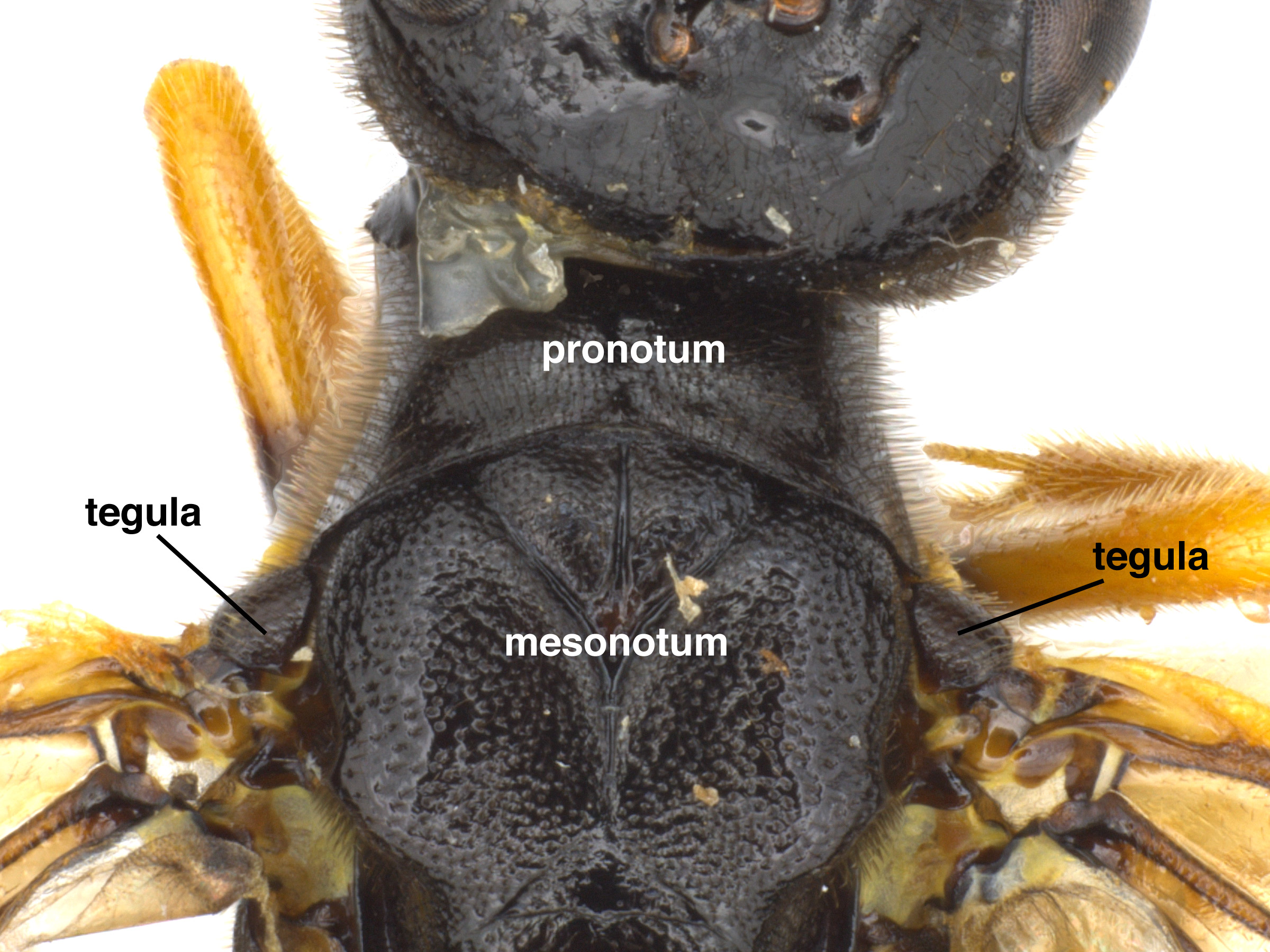 slightly constricted in the center, as seen from above (Goulet 1992Goulet 1992:
slightly constricted in the center, as seen from above (Goulet 1992Goulet 1992: as measured at the basebase:
as measured at the basebase: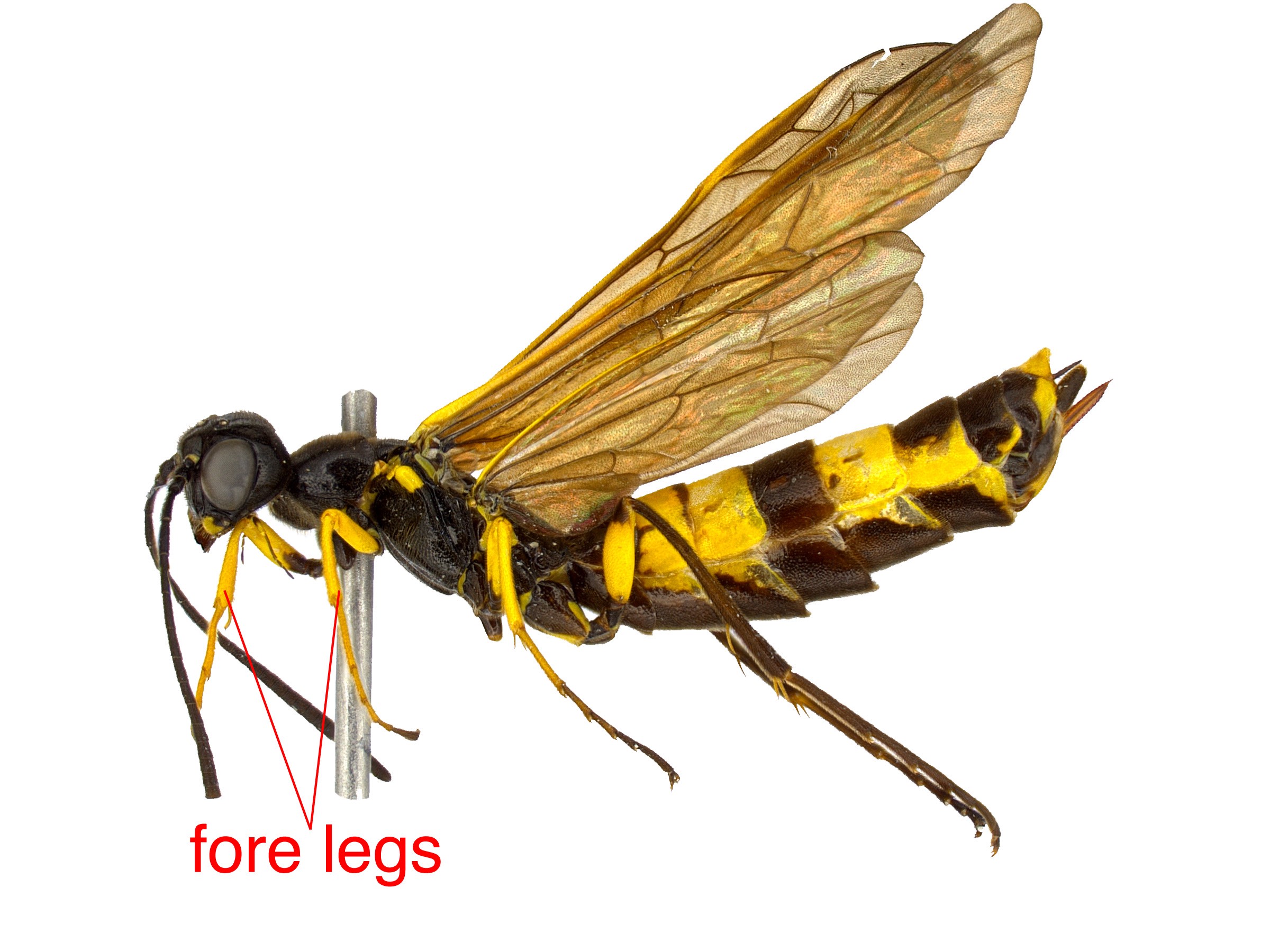 (Goulet 1992Goulet 1992:
(Goulet 1992Goulet 1992: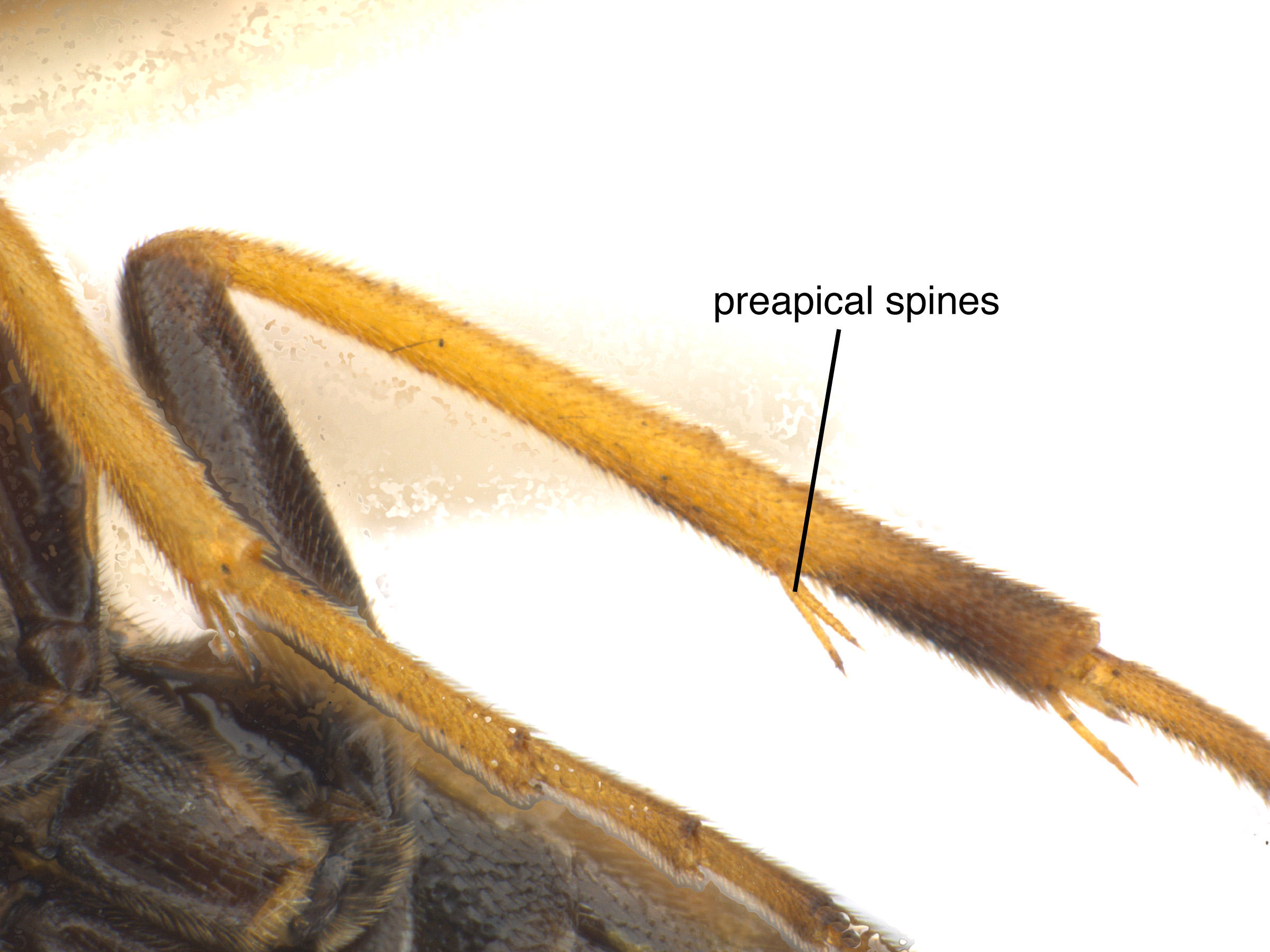 tibial spurs on the mid legmid leg:
tibial spurs on the mid legmid leg: (Goulet 1992Goulet 1992:
(Goulet 1992Goulet 1992: with 8–9 segments: scapescape:
with 8–9 segments: scapescape: , pedicelpedicel:
, pedicelpedicel: , and 6–7 flagellomeres (Smith and Schiff 1998Smith and Schiff 1998:
, and 6–7 flagellomeres (Smith and Schiff 1998Smith and Schiff 1998: located beyond the junction of veins R and Rs (Goulet 1992Goulet 1992:
located beyond the junction of veins R and Rs (Goulet 1992Goulet 1992: with a medial projection (Goulet 1992Goulet 1992:
with a medial projection (Goulet 1992Goulet 1992: deeply notched (Ross 1932)
deeply notched (Ross 1932)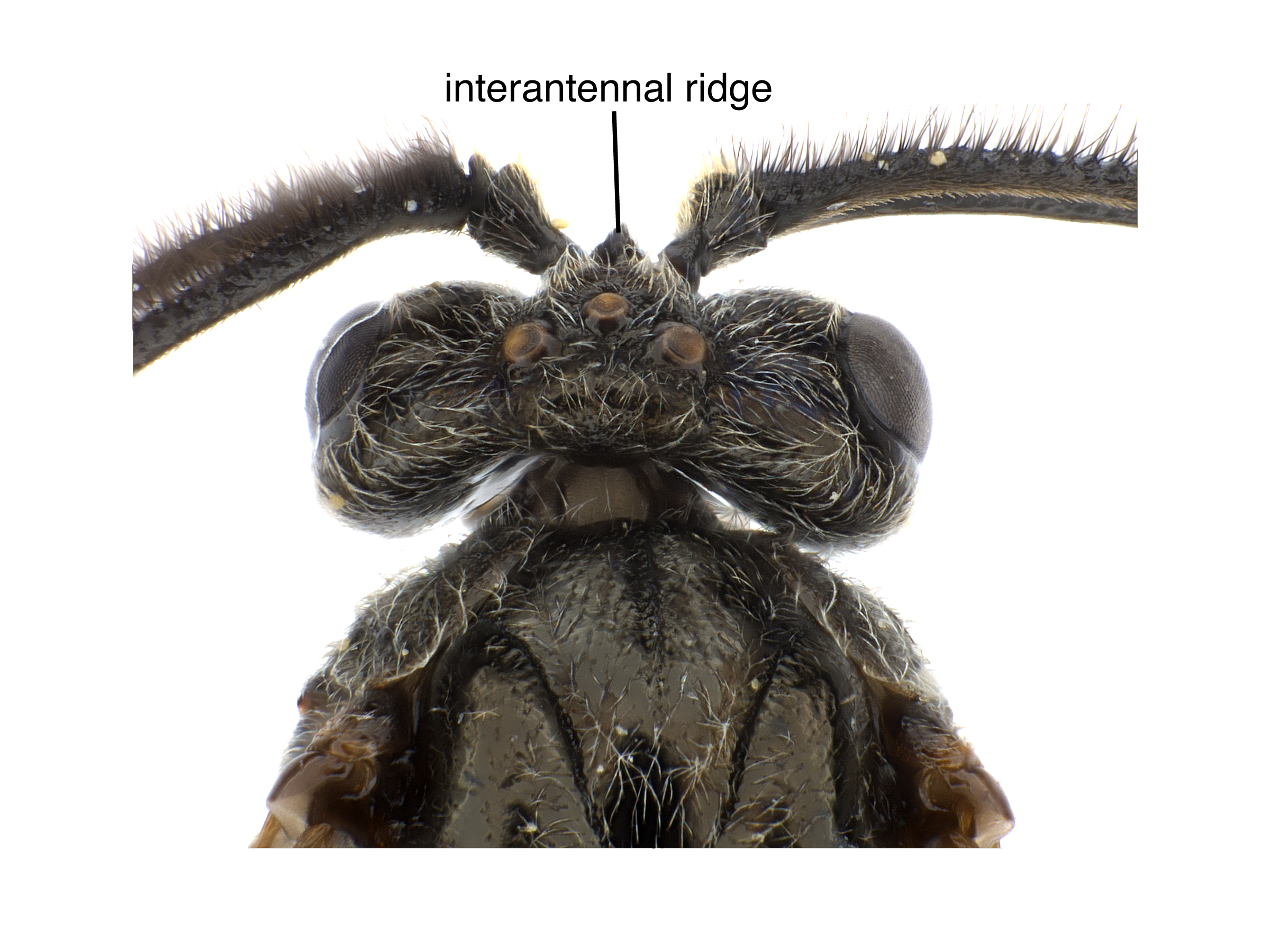 along inside edge of eye (Blank et al. 2017Blank et al. 2017:
along inside edge of eye (Blank et al. 2017Blank et al. 2017:Xyelidae can be distinguished from other families by the long ovipositorovipositor:
the female organ that deposits eggs and is used to drill into plant tissue, located at the apex of the abdomen, made up of the lance and lancet
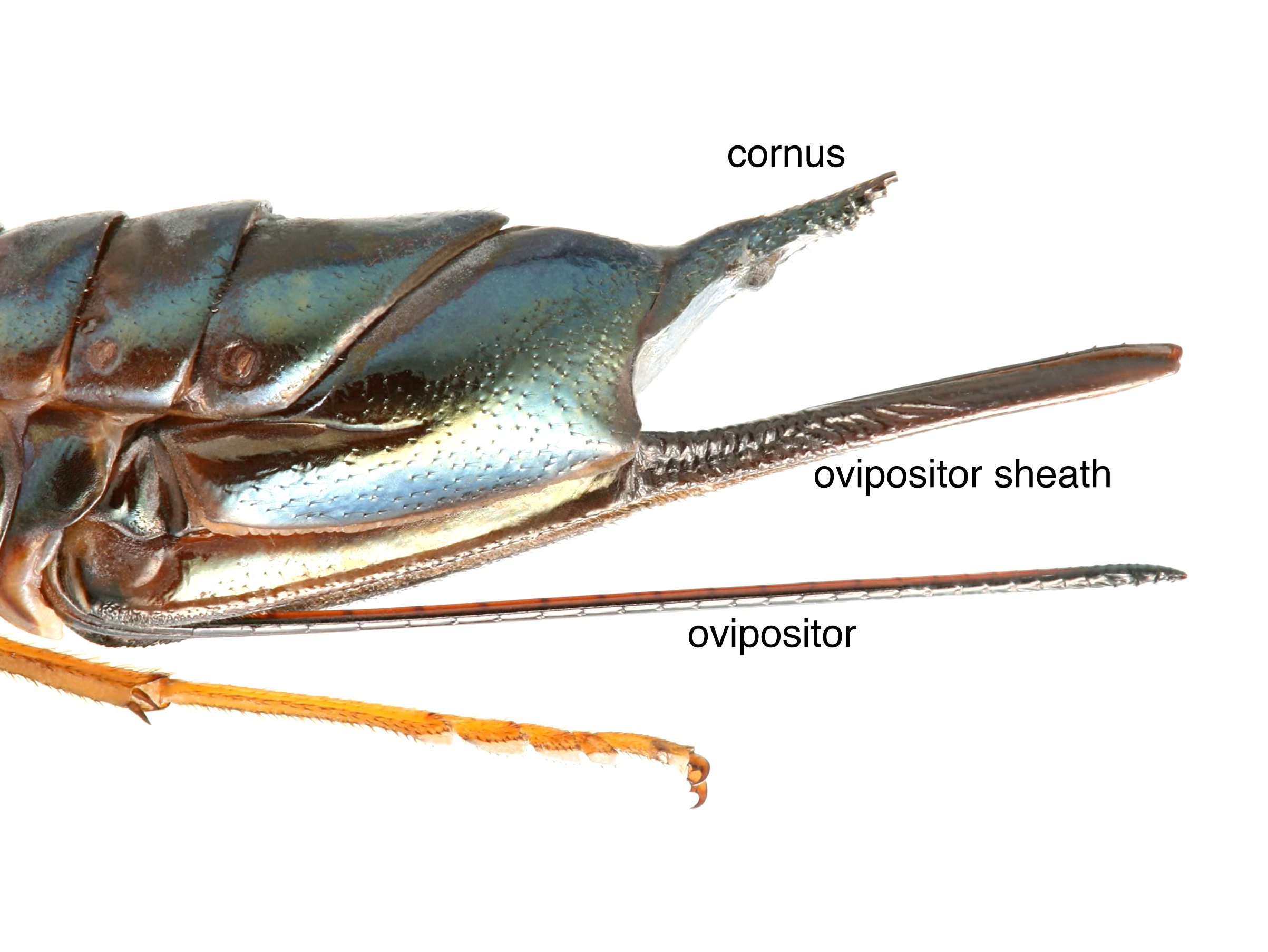 and the characteristic elongate third antennal segment wider than the remaining flagellumflagellum:
and the characteristic elongate third antennal segment wider than the remaining flagellumflagellum:
the third section of the antennae that includes all the segments beyond the pedicel; segments of the flagellum are known as flagellomeres
 . Megaxyela can be distinguished from Xyela and Pleroneura by the large size and from Xyelecia by the location of the Sc2/R veinvein:
. Megaxyela can be distinguished from Xyela and Pleroneura by the large size and from Xyelecia by the location of the Sc2/R veinvein:
a tube-like, often darkened, structure on the wings
 junction. It can be distinguished from Macroxyela by the shape of the clypeusclypeus:
junction. It can be distinguished from Macroxyela by the shape of the clypeusclypeus:
sclerotized area on the front of the head located between the antennal insertions and labrum
 and the carinacarina:
and the carinacarina:
a ridge or raised edge
 around the eye (Goulet 1992Goulet 1992:
around the eye (Goulet 1992Goulet 1992:
Goulet H. 1992. The genera and subgenera of the sawflies of Canada and Alaska: Hymenoptera. Symphyta. The insects and arachnids of Canada. Part 20. Agriculture Canada Publication., Blank et al. 2017Blank et al. 2017:
Blank SM, Kramp K, Smith DR, Sundukov YN, Wei M, and Shinohara A. 2017. Big and beautiful: the Megaxyela species (Hymenoptera, Xyelidae) of East Asia and North America. European Journal of Taxonomy 348: 1-46.).
none
Larvae are external leaf feeders recorded on species of Juglandaceae, including Carya illinoinensis (hardy pecan), other Carya sp. (hickory), Juglans cinerea (butternut), and other Juglans sp. (walnut) (Smith and Schiff 1998Smith and Schiff 1998:
Smith DR and Schiff NM. 1998. The genera Macroxyela Kirby and Megaxyela Ashmead (Hymenoptera: Xyelidae) in North America. Proceedings of the Entomological Society of Washington 100 (4): 636-657., Blank et al. 2017Blank et al. 2017:
Blank SM, Kramp K, Smith DR, Sundukov YN, Wei M, and Shinohara A. 2017. Big and beautiful: the Megaxyela species (Hymenoptera, Xyelidae) of East Asia and North America. European Journal of Taxonomy 348: 1-46.).
The female positions herself on the leaf with her abdomenabdomen:
the third and last segment of an insect's body; in sawflies this is usually made up of 11 segments (segments 9 and 10 often fused) at the apexapex:
at the apexapex:
the end or most distal area of any structure
, head towards the basebase:
the beginning or most proximal area of any structure
. She deposits one egg on the upper surface of the apexapex:
the end or most distal area of any structure
of the leaf, then slowly folds the leaf upwards, longitudinally along the midrib, sealing it with an excreted glue-like substance (Smith and Schiff 1998Smith and Schiff 1998:
Smith DR and Schiff NM. 1998. The genera Macroxyela Kirby and Megaxyela Ashmead (Hymenoptera: Xyelidae) in North America. Proceedings of the Entomological Society of Washington 100 (4): 636-657.). LarvaeLarva:
the immature stage of holometabolous insects
 are large, 22–28 mm in length at maturity, cylindrical, with brown head capsule and spiracles, as well as long, 6-segmented antennaeantenna:
are large, 22–28 mm in length at maturity, cylindrical, with brown head capsule and spiracles, as well as long, 6-segmented antennaeantenna:
the sensory organ emerging from the front of the head, usually between the compound eyes and above the clypeus; includes the flagellum, scape and pedicel
 (Smith 1967bSmith 1967b:
(Smith 1967bSmith 1967b:
Smith DR. 1967b. A review of the larvae of Xyelidae, with notes on the family classification (Hymenoptera). Annals of the Entomological Society of America 60 (2): 376-384., BugGuide 2019BugGuide 2019:
BugGuide. Accessed January 2019. https://bugguide.net). Typically, the larvaelarva:
the immature stage of holometabolous insects
 are situated wrapped around the basebase:
are situated wrapped around the basebase:
the beginning or most proximal area of any structure
of a leaf. As the larvaelarva:
the immature stage of holometabolous insects
 mature, they feed on the young leaves of the tree. Around June, larvaelarva:
mature, they feed on the young leaves of the tree. Around June, larvaelarva:
the immature stage of holometabolous insects
 will fall to the ground and build a cocoon to pupate (Smith 1967bSmith 1967b:
will fall to the ground and build a cocoon to pupate (Smith 1967bSmith 1967b:
Smith DR. 1967b. A review of the larvae of Xyelidae, with notes on the family classification (Hymenoptera). Annals of the Entomological Society of America 60 (2): 376-384., Smith and Schiff 1998Smith and Schiff 1998:
Smith DR and Schiff NM. 1998. The genera Macroxyela Kirby and Megaxyela Ashmead (Hymenoptera: Xyelidae) in North America. Proceedings of the Entomological Society of Washington 100 (4): 636-657.).
Adults fly during April and May. Megaxyela are univoltineunivoltine:
describing an insect with a life cycle of one generation per year
(Smith and Schiff 1998Smith and Schiff 1998:
Smith DR and Schiff NM. 1998. The genera Macroxyela Kirby and Megaxyela Ashmead (Hymenoptera: Xyelidae) in North America. Proceedings of the Entomological Society of Washington 100 (4): 636-657.).
World: Megaxyela is recorded in North America and in East Asia, specifically in China, Korea, Russia, and Japan (Taeger et al. 2010Taeger et al. 2010:
Taeger A, Blank SM, and Liston AD. 2010. World Catalog of Symphyta (Hymenoptera). Zootaxa 2580: 1-1064., Blank et al. 2017Blank et al. 2017:
Blank SM, Kramp K, Smith DR, Sundukov YN, Wei M, and Shinohara A. 2017. Big and beautiful: the Megaxyela species (Hymenoptera, Xyelidae) of East Asia and North America. European Journal of Taxonomy 348: 1-46.).
North America: In North America, the range of Megaxyela is restricted to the eastern United States, from the Midwest east to the mid-Atlantic region, and Ontario, Canada (Blank et al. 2017Blank et al. 2017:
Blank SM, Kramp K, Smith DR, Sundukov YN, Wei M, and Shinohara A. 2017. Big and beautiful: the Megaxyela species (Hymenoptera, Xyelidae) of East Asia and North America. European Journal of Taxonomy 348: 1-46.).
Map data from: GBIF.org (26 June 2019) GBIF Occurrence Download Megaxyela
Details about data used for maps can be found here.